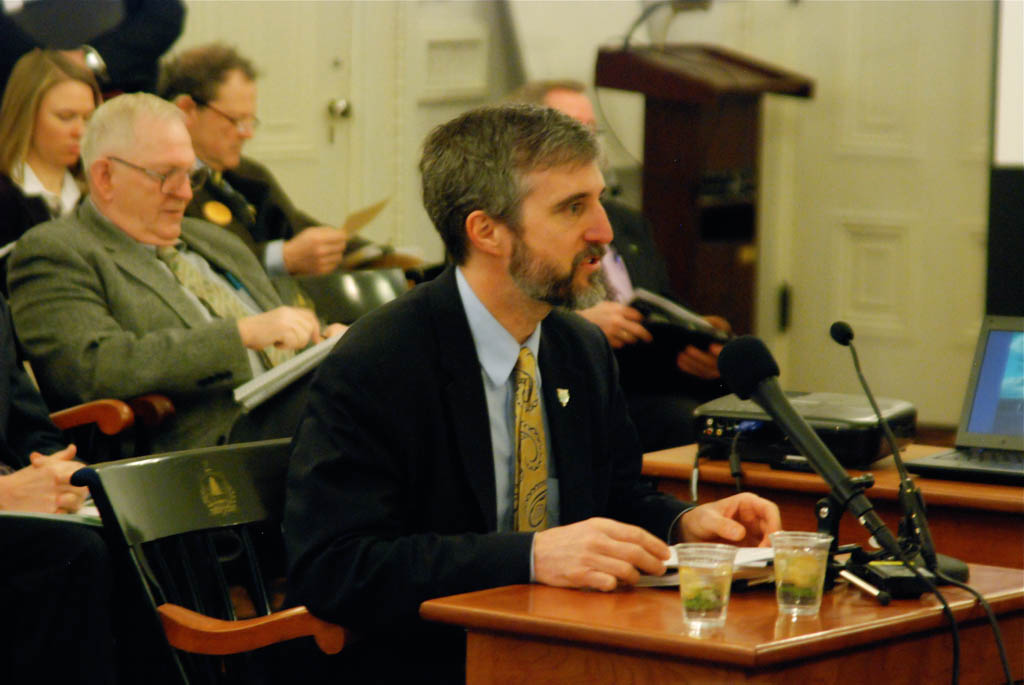
A visit from a federal official Wednesday served as a reminder to lawmakers that the clock is ticking on a mandate to clean up Lake Champlain.
The Environmental Protection Agency expects a letter from the Legislature and Gov. Peter Shumlin by the end of March spelling out timelines and priorities for easing phosphorus pollution in the lake.
The nation’s sixth-largest body of fresh water, which many say is critical to Vermont’s quality of life and economy, does not meet water quality standards set by federal regulators. The state must clean up the lake or face tightened wastewater regulations and cutbacks in federal support, EPA officials say.
Stephen Perkins, director of ecosystem protection for the EPA, drove home the point Wednesday.
“We want to get a clear picture of what programs will be implemented by when,” Perkins told lawmakers. “We want to see how all of that lays out to have confidence that stuff is going to happen.”
Without a commitment from the state, the EPA said it will clamp down on sources of water pollution, namely water treatment plants. The state would then be required to upgrade the facilities at a huge cost or challenge the regulations in court, according to state Department of Environmental Conservation Commissioner David Mears.
“We’ll spend a lot of money on lawyers, we’ll spend a lot of money on forcing the more developed areas of our state to have to invest more in sewage treatment capacity, we’ll be requiring the largest developers of the state to shoulder the largest burden of the cost on some major developments. And all of that will contribute. It will help reduce the problem, but it will not get us to where we need to go,” Mears said.
The EPA will issue its final Lake Champlain Total Maximum Daily Load (TMDL) report, which sets a standard for phosphorus pollution into the lake, this summer. State agencies, already working to clean up the lake with tight resources, will be required to look inland to the state’s forests, roads, farms and urban landscapes to reach the goal of reducing the lake’s phosphorus loading by 36 percent.
Lawmakers asked what would happen if the state refused to pitch in for the cleanup.
“In this situation, under the Clean Water Act, it’s not really a question about whether the state of Vermont as a whole pays for these cleanup obligations. We will be paying one way or the other,” Mears said.
Under the Clean Water Act, the EPA regulates point sources of water pollution, such as water treatment and sewage facilities that channel processed wastewater into the lake. But now the state is looking inland to rectify the lake’s water quality.
“We’re largely a rural state. Most of the pollution that’s going into the lake comes from the landscape,” Mears said. “Over 95 percent of the pollution comes from stormwater runoff. It’s not coming from those pipes.”
Mears said the cleanup will require state dollars, but federal and existing municipal funds used to manage stormwater can also be tapped. Next year, Mears said the agency will return to the Statehouse with specific cost estimates and strategic investment proposals.
A group of environmental advocates hosted a news conference after the hearing to urge the administration to make the commitment.
Christopher Kilian, vice president of the Conservation Law Foundation, recommended placing a fee on commercial development to pay for the cleanup.
Kilian said taxpayers should not have to shoulder the entire bill to clean up the lake. Instead, he said privately owned big box stores should pay for the stormwater runoff from their parking lots.
“Those facilities can be required to retrofit their footprint on order to protect Lake Champlain,” he said “And, frankly, taxpayers should not be helping big box stores comply with environmental laws through public subsidies, that’s not fair to the taxpayer.”
Lawmakers are working through a package of water quality legislation this session, including a shorelands protection law to require permits for lakeshore development under certain conditions, which passed the Senate this year.
In addition, an omnibus water quality bill, H.586, is currently under review in committee.
Lawmakers have proposed a an annual stormwater fee for all developed property (sometimes referred to as the per parcel fee) to cover the cost of cleaning up runoff.
The Vermont Citizens Advisory Committee on the Future of Lake Champlain has presented lawmakers with several other investment options, including a fertilizer tax, redirection of federal funds currently used for wastewater treatment facilities and a bottled water tax. They also suggested the state’s Current Use Program could encourage land stewardship.
Perkins, of the EPA, said the agencies charged with the cleanup must have the proper authority to carry out the state’s plan.
“I think it’s fair to say that we are supportive of making sure that all of the agencies that have stuff to do here have proper authority to take the measures that are described here,” Perkins said in an interview after the hearing.
He continued, “And, you know, to the extent that (House bill) 586 deals with funding, again, anything that makes it more likely that the funds are available for implementing these things is very positive.”
